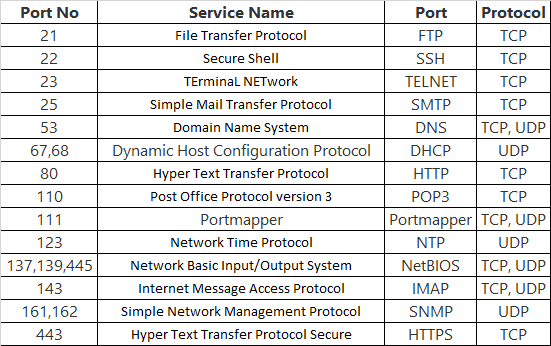Ports are essential communication endpoints that enable different applications and services to communicate with each other over a network connection. Each port is associated with a specific protocol or service and is identified by a unique number. We will explore common ports used in networking and provide an overview of their associated protocols and services.
Understanding these ports is vital for network administrators as it allows them to identify and troubleshoot issues related to network connectivity and security. We will cover widely used ports such as FTP, SSH, Telnet, SMTP, DNS, DHCP, HTTP, POP3, Portmapper, NTP, NetBIOS, IMAP, SNMP, and HTTPS.
FTP (File Transfer Protocol): Port 21 is used for FTP, which is a standard protocol used for transferring files over the internet.
SSH (Secure Shell): Port 22 is used for SSH, which is a secure network protocol used for remote access to a computer or server.
Telnet(TErminaL NETwork): Port 23 is used for Telnet, which is an older network protocol that provides remote shell access to a computer or server. It is not secure and has largely been replaced by SSH.
SMTP (Simple Mail Transfer Protocol): Port 25 is used for SMTP, which is the protocol used for sending email messages between servers.
DNS (Domain Name System): Port 53 is used for DNS, which is the protocol used for translating human-readable domain names into IP addresses.
DHCP (Dynamic Host Configuration Protocol): Port 67 and 68 are used for DHCP, which is a protocol used for automatically assigning IP addresses to devices on a network.
HTTP (Hypertext Transfer Protocol): Port 80 is used for HTTP, which is the protocol used for transferring data over the World Wide Web.
POP3 (Post Office Protocol version 3): Port 110 is used for POP3, which is a protocol used for retrieving email messages from a mail server.
Portmapper: Port 111 is used for Portmapper, which is a protocol used for mapping RPC (Remote Procedure Call) services to their respective port numbers.
NTP (Network Time Protocol): Port 123 is used for NTP, which is a protocol used for synchronizing clocks on computer systems.
NetBIOS(Network Basic Input/Output System): Port 137, 139 and 445 are used for NetBIOS, which is a protocol used for communication between computers on a local area network (LAN).
IMAP (Internet Message Access Protocol): Port 143 is used for IMAP, which is a protocol used for retrieving email messages from a mail server.
SNMP (Simple Network Management Protocol): Port 161 and 162 are used for SNMP, which is a protocol used for managing and monitoring network devices.
HTTPS (Hypertext Transfer Protocol Secure): Port 443 is used for HTTPS, which is a secure version of HTTP that uses SSL/TLS encryption to protect sensitive data.
Essential Ports for Linux Servers:
 Reviewed by ITAdmin
on
April 01, 2023
Rating:
Reviewed by ITAdmin
on
April 01, 2023
Rating:
 Reviewed by ITAdmin
on
April 01, 2023
Rating:
Reviewed by ITAdmin
on
April 01, 2023
Rating:






No comments: